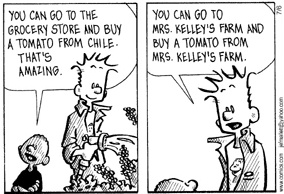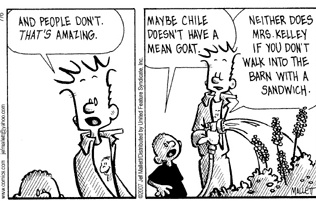Why it's a good bet to bet in favor of U.S. decline

Frames one and two, Frazz comic strip, July 6th, 2007
From "Obesity Task Force Extends Study," in Adweek:
A government task force examining the effect the media might have on childhood obesity delayed the release of its report on Thursday. Sens. Sam Brownback, R-Kan., and Tom Harkin, D-Iowa, along with FCC chairman Kevin Martin, said they expect the committee to finish its work in the fall instead of mid-summer as originally planned.
"The extension will allow for a more thorough examination of new initiatives that many of the food and beverage companies are coordinating, as well as a more comprehensive look at how all parties, especially media, can work together for the common good," Brownback and Harkin said in a joint statement.
From the AP story "Nutrition education efforts failing":
The federal government will spend more than $1 billion this year on nutrition education -- fresh carrot and celery snacks, videos of dancing fruit, hundreds of hours of lively lessons about how great you will feel if you eat well. But an Associated Press review of scientific studies examining 57 such programs found mostly failure. Just four showed any real success in changing the way children eat -- or promise as weapons against childhood obesity...
THE OBSTACLES:
Parents -- Experts agree that parents have the greatest influence, even a biological influence, over what their children will eat. "If the mother is eating Cheetos and white bread, the fetus will be born with those taste buds. If the mother is eating carrots and oatmeal, the child will be born with those taste buds," said Dr. Robert Trevino of the Social and Health Research Center in San Antonio.
Poverty -- Poorer children are especially at risk, because unhealthy food is cheaper and more easily available. Parents are often working, leaving children unsupervised and with access to snacks. Low-income neighborhoods have fewer good supermarkets with fresh produce.
Advertising -- Children age 8 to 12 see an average of 21 television ads each day for candy, snacks, cereal and fast food -- more than 7,600 a year, according to a recent Kaiser Family Foundation study. Not one of the 8,854 ads reviewed promoted fruits or vegetables.
Hmm, I bet all those new initiatives from the food and beverage companies will take these results into account. On the other hand, maybe there is hope. See "The Debate Over Subsidizing Snacks," from the New York Times.

Frames three and four, Frazz comic strip, July 6th, 2007
Labels: bad government, food-agriculture-markets, good government



0 Comments:
Post a Comment
<< Home